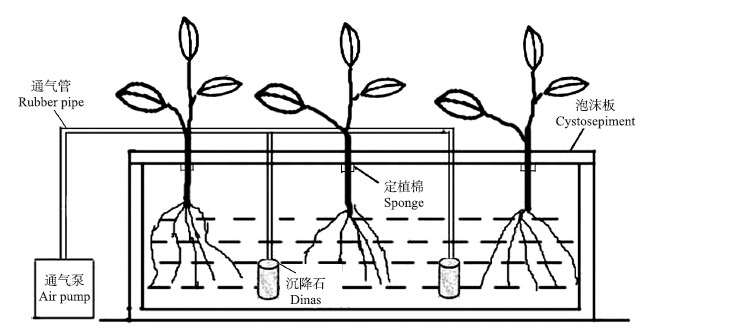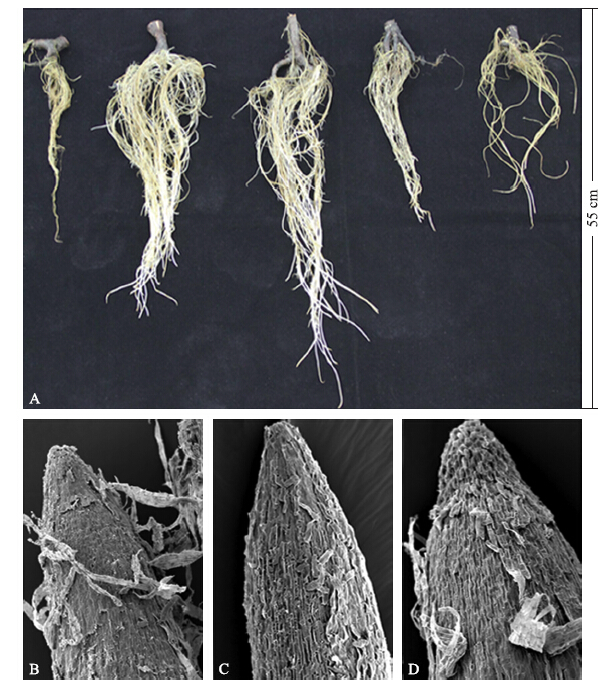
文章信息
- 王英珍, 张虎平, 黄小三, 王纪忠, 程瑞, 陈国栋, 张绍铃
- WANG Yingzhen, ZHANG Huping, HUANG Xiaosan, WANG Jizhong, CHENG Rui, CHEN Guodong, ZHANG Shaoling
- 钾在梨树内的分配及对梨树生长和叶片光合能力的影响
- Effect of potassium supply on plant potassium distribution and growth and leaf photosynthetic capacity of Pyrus pyrifolia
- 南京农业大学学报, 2017, 40(1): 60-67
- Journal of Nanjing Agricultural University (Social Science), 2017, 40(1): 60-67.
- http://dx.doi.org/10.7685/jnau.201603054
-
文章历史
- 收稿日期: 2016-03-28
2. 淮阴工学院生命科学与食品工程学院, 江苏 淮安 223003
2. College of Life Sciences and Food Engineering, Huaiyin Institute of Technology, Huai'an 223003, China
钾是植物代谢最重要的营养元素之一[1-2],在植物生长过程中起着非常重要的作用。它不仅是植物体内60多种酶的活化剂,而且可以调节细胞膨压、提高植物抗旱性[3]、维持细胞电荷平衡[4]、促进光合产物运输和蛋白质合成。梨树在生长或形成新器官时,都需要有钾的存在[5],严重缺钾可引起树体死亡。我国有将近1/3的土壤缺钾,有研究表明,江苏地区的土壤钾含量正在以每年2.3 mg · kg-1的速度下降[6]。国内钾肥资源短缺[7],长期依赖进口,近年来进口钾肥的价格不断上升,极大地提高了生产成本,加重了农民的负担[8]。而施钾过多不仅会造成资源浪费,而且会使梨树产生抗逆反应,阻碍树体生长。在梨树生产中,经验施肥的现象较为普遍,许多地方施肥过重,导致土壤板结,产量降低。因此,钾肥浓度过高或过低均不利于梨树的生长,研究不同钾浓度下梨树的根系生长及叶片光合状态,对于平衡施肥,减少化肥施用,发展生态农业及农民增收都具有重要意义。
钾对果树的作用主要表现在果实品质和光合能力上,所以被称为“品质元素”。孙骞等[9]在猕猴桃上的研究表明,每株施500 g的钾可以增加叶绿素含量,激活叶片电子传递活性,提高PSⅡ原初光能的转化效率;曲桂敏等[10]在苹果上的研究表明施用钾肥可以通过提高光合效率降低蒸腾效率来改善苹果树的水分利用效率;余倩倩等[11]的研究表明,一定水平的施钾处理可以提升锦橙幼树的株高以及各组织的钾含量;何忠俊等[12]研究表明钾可以提升‘砀山酥梨’果实品质,降低新梢生长量,增加百叶质量和叶绿素含量。这些研究结果表明钾对果树叶片生长和果实发育具有重要作用,但是对梨树体内钾的分配规律、叶绿素荧光特性及叶绿体超微结构却鲜有研究。且前人的研究大多是在田间进行,具有许多不可控因素,而水培条件下梨树生长所需的营养全部由营养液供应,可控性高,对于深入了解钾在梨树体内的分配及作用具有重要意义。鉴于此,本研究以一年生‘翠冠’梨树嫁接苗为试验材料,利用水培法研究了不同钾浓度条件下梨幼树不同部位钾元素分配规律、根系生长特性和叶片光合能力,旨在为梨树生产中合理施用钾肥,改善光合性能,提升果实产量和品质提供理论依据。
1 材料与方法 1.1 试验材料供试梨树品种为一年生‘翠冠’嫁接苗,砧木为杜梨。
1.2 方法试验于2015年3月至8月在南京农业大学梨工程技术中心进行。参考张绍铃[13]的方法,在梨树水培前,留3~5个饱满芽进行短截,并对根系进行修剪,主根保留8~10 cm,每7 d换1次营养液,调整pH值为6.5±0.1。水培采用改良Hoagland营养液配方[14]进行,配方如下:6 mmol · L-1 KNO3,4 mmol · L-1Ca(NO3)2,1 mmol · L-1 NH4H2PO4,2 mmol · L-1 MgSO4,50 μmol · L-1 Fe-EDTA,5 μmol · L-1 KI,0.1 mmol · L-1 H3BO3,1.2 μmol · L-1 Na2MoO4,0.16 μmol · L-1 CuSO4,0.19 μmol · L-1 CoCl2,16 μmol · L-1 MnCl2。为确保不同处理下梨树症状差异明显,试验以标准营养液中钾浓度(6 mmol · L-1)为对照,将钾浓度为30和60 mmol · L-1作为高钾处理,3 mmol · L-1作为低钾处理,0 mmol · L-1为缺钾处理。同时,为使各处理营养液增加KNO3后N浓度维持正常,分别在溶液中加入6 mmol · L-1 NaNO3,3 mmol · L-1 KNO3+3 mmol · L-1 NaNO3,6 mmol · L-1 KNO3+12 mmol · L-1 K2SO4,6 mmol · L-1 KNO3+27 mmol · L-1 K2SO4,从而使钾的浓度达到0、3、30、60 mmol · L-1,N的浓度保持不变。
水培装置如图 1所示,培养容器长、宽、高为 60 cm、40 cm、15 cm,内放20 L营养液并栽植3株‘翠冠’嫁接苗。梨树用泡沫板固定,每隔3 h向营养液中通气15 min。连续培养16周后,将所有幼苗分成根、茎、叶3部分,分别称质量,蒸馏水冲洗,并105 ℃杀青20 min,75 ℃烘干至恒质量,称量干质量,研磨后,待测。

|
图 1 梨树水培装置示意图 Figure 1 A hydroponic plant schematic diagram of grafted young plant‘Cuiguan’pear |
叶绿素含量的测定参照王学奎[15]的方法;叶面积采用浙江托普YMJ-C型叶面积仪测定。用根系扫描仪(LA1600 scanner,Canada)获得根系图像,用根系分析软件(Winrhizo 2003b,Cannda)对相关指标如根系体积、根系长度、根系表面积进行分析。选取0、6、60 mmol · L-1 KNO3处理的新鲜须根0.5 cm(含根尖),用蒸馏水清洗,浸泡于0.1 mmol · L-1 磷酸缓冲液(PBS)配制的2.5%(体积分数)戊二醛中固定;固定后用蒸馏水清洗3次,每次20 min,然后用乙醇脱水,在日立-S3000N扫描电子显微镜下观察根尖形态并拍照。选取上述3个处理的叶片,沿着叶脉取0.1 cm×0.1 cm,迅速投入5%戊二醛固定液中,用真空抽气泵抽真空至叶片下沉为止,于4 ℃冰箱中固定24 h,用0.1 mmol · L-1PBS冲洗,然后用1%锇酸溶液固定4 h,再用双蒸水冲洗,乙醇脱水,Epon812环氧树脂包埋,LKB V型超薄切片机切片,经醋酸双氧铀和柠檬酸铅染色后于日立H-7650透射电镜下观察叶绿体形态结构并拍照。叶绿素荧光参数采用英国Hansatech公司多功能植物效率仪(M-PEA)测定,每个处理测15片叶,取平均值。根、茎、叶中钾元素的提取采用微波消解法,以去离子水调整至45 mL,并用电感耦合等离子发射光谱仪(ICP)测定。钾积累量(g)=组织钾浓度×组织干质量;钾分配比例=组织钾积累量/整株钾积累量×100%。
1.4 数据处理采用SPSS 18.0 软件进行统计分析,并用Duncan′s新复极差法检验其差异显著性。
2 结果与分析 2.1 不同钾水平下梨树的钾含量及分配比例从图 2可以看出:不同钾浓度下,梨树根、茎、叶中的钾含量随外界钾浓度升高而升高(图 2-A)。相同供钾浓度下,梨树根、茎、叶3个组织中,钾在叶片中的分配比例最高(图 2-B),说明叶片是主要积累钾的部位。但当供钾浓度为60 mmol · L-1时,钾在叶片中分配比例显著低于对照(P<0.05),在茎中的分配比例显著高于对照,表明高钾条件下茎中的钾向叶片中运输受阻。

|
图 2 不同钾浓度下‘翠冠’梨树器官中钾含量与分配比例 Figure 2 Potassium content and distribution ratio of different organs in grafted young plant‘Cuiguan’pear treated with different potassium concentration 不同小写字母表示差异显著(P<0.05)。Different small letters indicate significant difference at 0.05 level. The same as follows. |
不同钾浓度下梨树根系形态不同(图 3-A),根尖外观形态结构也发生了变化。低钾条件下,根系外表皮毛数量较多,表面凹凸不平(图 3-B);对照钾处理的根尖细胞和组织大小均一,表面平整(图 3-C);高钾条件下根尖变形,开始皱缩,发生龟裂(图 3-D)。

|
图 3 不同钾浓度对‘翠冠’梨根系形态的影响 Figure 3 Effect of different potassium concentration on the root morphology of grafted young plant‘Cuiguan’pear A:不同钾浓度下梨树的根系形态(由左至右各处理钾浓度分别为:0、3、6、30和60 mmol · L-1);B:0 mmol · L-1 KNO3,表皮毛数量较多(×200),根尖凹凸不平;C:6 mmol · L-1 KNO3,细胞和组织大小均一,表面平滑(×200);D:60 mmol · L-1 KNO3,根尖皱缩,发生龟裂(×200)。 A:Roots of pear under the treatment of different potassium concentration(the potassium concentration from left to right is 0,3,6,30,60 mmol · L-1);B:0 mmol · L-1 KNO3,lots of epidermal hairs,and the surface is not flat(×200);C:6 mmol · L-1 KNO3,normal root tip with smooth surface(×200);D:60 mmol · L-1 KNO3,the root tip is abnormal and rimous(×200). |
不同供钾浓度下,‘翠冠’梨根系生长指标也各不相同。与对照相比,当供钾浓度为30和60 mmol · L-1 时,总根长、根系表面积、根系体积和根尖数均显著降低;而根系平均直径显著高于对照(表 1)。
| c(K+)/ (mmol·L-1) | 总根长/cm Root length | 根系表面积/cm2 Root surface area | 根系体积/cm3 Root volume | 根系平均直径/mm Average root diameter | 根尖数 Root tip number |
| 0 | 546.31±90.59c | 104.52±8.63d | 1.64±0.28c | 0.55±0.04d | 1 638±143e |
| 3 | 11 725.64±1 438.90a | 2 195.86±57.81b | 32.52±2.98a | 0.62±0.02c | 51 435±311b |
| 6 | 12 089.61±615.24a | 2 423.21±35.02a | 35.42±1.58a | 0.65±0.03c | 57 383±674a |
| 30 | 3 826.86±230.16b | 859.04±57.60c | 15.39±2.77b | 0.71±0.01b | 17 960±762c |
| 60 | 3 661.27±138.97b | 872.03±47.94c | 16.84±3.28b | 0.78±0.04a | 15 929±734d |
由表 2可见:与对照相比,其他各处理新梢总长下降了35.2%~62.36%,新梢粗下降了11.11%~38.88%,地上部干质量下降了19.37%~30.58%,地下部干质量下降了31.43%~80.57%,根冠比下降了13.88%~72.06%。说明高钾和低钾严重影响梨树的生长,特别是对植株地下部的抑制作用最为显著。
| c(K+)/ (mmol·L-1) | 新梢总长/cm Shoot length | 新梢粗/cm Shoot diameter | 地上部干质量/g Shoot dry mass | 地下部干质量/g Root dry mass | 根冠比 Root/shoot ratio |
| 0 | 31.17±2.08d | 0.11±0.02c | 20.07±1.57c | 0.34±0.05c | 0.016 9±0.002 2c |
| 3 | 53.67±5.39b | 0.15±0.01ab | 23.31±0.62b | 1.20±0.18b | 0.052 1±0.007 4a |
| 6 | 82.83±4.01a | 0.18±0.02a | 28.91±1.31a | 1.75±0.14a | 0.060 5±0.003 2a |
| 30 | 49.00±4.09b | 0.16±0.01a | 21.80±0.69bc | 0.60±0.10c | 0.027 6±0.005 1b |
| 60 | 39.00±3.50c | 0.13±0.01bc | 20.13±1.94c | 0.65±0.12c | 0.032 3±0.006 7b |
由表 3可见:总叶面积先升高后下降,在钾浓度为6 mmol · L-1时达到最大值。而叶绿素含量则是随供钾浓度的升高而增加,当钾浓度为0和3 mmol · L-1时叶绿素含量显著小于其他处理。当钾浓度为60 mmol · L-1时,植株叶片的PSⅡ潜在活性(Fv/Fo)、以吸收光能为基础的性能指数(PIABS)以及最大光化学效率(Fv/Fm)均显著低于对照,而J相相对荧光(Vj)、放氧复合体受抑程度(Wk)、达到最大荧光所需的时间(Tfm)3个指标则显著高于对照。说明高钾降低了PSⅡ反应中心的活性,阻碍了光合电子链的传递。
| c(K+)/ (mmol·L-1) | 总叶面积/cm2 Leaf area | 叶绿素含量/(mg·g-1) Chlorophyll content | Fv/Fo | Fv/Fm | Vj | Wk | Tfm | PIABS |
| 0 | 589.52±50.13c | 2.75±0.05b | 4.71±0.66ab | 0.82±0.02ab | 0.26±0.01bc | 0.32±0.02b | 387.37±36.09a | 9.21±2.53ab |
| 3 | 904.79±35.93b | 3.29±0.73b | 5.01±0.37ab | 0.84±0.01a | 0.25±0.01c | 0.31±0.02b | 359.00±10.15ab | 10.69±0.53a |
| 6 | 1 110.89±44.84a | 4.46±0.21a | 5.12±0.10a | 0.85±0.01a | 0.25±0.03c | 0.31±0.01b | 345.00±20.00b | 11.22±2.70a |
| 30 | 619.18±53.14c | 4.51±0.24a | 4.56±0.18ab | 0.83±0.02ab | 0.29±0.01ab | 0.33±0.01ab | 385.15±10.52a | 7.47±0.31b |
| 60 | 570.32±57.73c | 4.88±0.32a | 4.37±0.24b | 0.81±0.01b | 0.30±0.01a | 0.35±0.02a | 390.33±13.43a | 7.25±0.52b |
由图 4可见:当钾浓度为6 mmol · L-1时,‘翠冠’叶片叶绿体内结构良好,膜结构完整(图 4-e),嗜锇颗粒较少,淀粉粒饱满(图 4-b),基质片层和基粒片层清晰(图 4-h),表明植株生长旺盛,光合产物积累较多。缺钾(0 mmol · L-1)和高钾(60 mmol · L-1)时,叶绿体结构均遭到不同程度的破坏,光合产物积累较少,叶片衰老严重。

|
图 4 不同钾浓度下‘翠冠’梨叶片的叶绿体超微结构 Figure 4 Ultrastructure of chloroplasts in grafted young plant‘Cuiguan’pear leaves treated with different potassium concentration a:淀粉粒少,嗜锇颗粒多;b:淀粉粒多且饱满,嗜锇颗粒较少;c:无淀粉粒;d:叶绿体被膜结构遭破坏;e:叶绿体膜结构完整;f:叶绿体膜结构完整;g:多数基粒片层溶解,部分基质片层断裂;h:叶绿体片层结构清晰完整;i:部分基粒片层溶解。 P:嗜锇颗粒;S:淀粉粒;Ch:叶绿体;Ce:叶绿体被膜;GL:基粒片层;SL:基质片层。 a:The number of starch were less and the plastoglobulus was more;b:The number of starch were increased and the size was big,the number of plastoglobulus were decresased;c:No starch;d:The chloroplast envelope was destroyed;e:The chloroplast was flawless;f:The chloroplast was flawless;g:Most of the stroma lamella were fractured,thegrana lamella were disaggregated;h:Troma lamella and grana lamella were flawless;i:A fraction of grana lamella was disaggregated. P:Plastoglobulus;S:Starch;Ch:Chloroplast;Ce:Chloroplast envelope;GL:Grana lamella;SL:Storma lamella. |
钾在植株体内是高速移动着的,主要集中在生长活动旺盛的部分[16-17]。已有研究表明:无论是高钾或低钾处理之下,玉米‘豫玉23’和‘兴农998’各器官的钾浓度从大到小依次为上部叶、中部叶、下部叶、根;与高钾处理相比,低钾降低2个品种各器官和整株的钾积累量[18]。卢颖林等[19]研究表明,在低钾处理下斑茅云南82-85、海南92-109和广西87-3这3个材料的地上部、根系和植株钾累积量均显著低于高钾处理。本研究结果也表明随着供钾浓度的升高,梨树根、茎、叶各器官的钾含量也随之升高。而且在各钾处理水平条件下,叶片中的钾分配比例最高,说明叶片是钾的主要分配器官,这和侯岑等[20]在梨树上的研究结果一致。但当钾浓度高于30 mmol · L-1时,叶片中的钾分配比例开始下降,茎中的钾分配比例开始升高,说明高钾条件下,钾从茎到叶的运输受阻,这可能是植物对高钾的一种调节机制。
不同钾浓度下,植株生长状况不同的原因可以归结为以下两方面:一方面是钾的直接作用,高钾或低钾水平下植株体内钾吸收、转运、分配和利用异常[21],导致生长受阻,光合性能下降。本研究中,当钾浓度由6 mmol · L-1升至60 mmol · L-1时,梨叶片中的钾浓度增加了98.53%,这可能也是高钾导致梨叶绿体结构损坏,光合电子传递受阻的原因。另一方面,高钾或低钾会导致营养液中元素比例失调,导致其他离子如Ca2+、NH4+、Mg2+等的吸收受阻,打破了植株体内的离子平衡,从而影响植株的生长发育。但是,在梨树内对于不同钾水平引起的离子失衡所产生的不利影响尚需进一步的研究予以证实。
根系是外界钾作用最直接的部位,也是植物吸收水分和养分的主要器官,因此根系的发育情况很大程度上影响着植株的生长。已有研究表明,钾的富集可以诱导根系的系统响应,促进整个根系的生长[22-23]。潘艳花等[24]研究表明施钾会影响西瓜幼苗根系形态的变化,不施钾会明显抑制根系的生长;陈际型[25]的研究表明缺钾会抑制根系的生长。本研究表明,高钾或缺钾状态下,总根长、根系表面积、根系体积和根尖数均显著低于对照,然而高钾条件下根系平均直径却显著高于对照,说明钾可能促进梨树根系的膨大,但浓度过高和过低都会不同程度地抑制根系的伸长生长和形态建成。高钾或缺钾不但会影响根系的生长,而且对整个梨树的生长也有显著的抑制作用。本研究表明缺钾和高钾均会不同程度地影响植株的新稍生长及干物质积累。本研究通过对不同钾浓度下植株叶绿体超微结构的观察发现,缺钾条件下叶绿体结构遭到破坏,嗜锇颗粒增多,严重影响光合产物的积累。且高钾会降低PSⅡ的潜在活性(Fv/Fo)以及最大光化学效率(Fv/Fm),增加放氧复合体受抑制程度(Wk)以及达到最大荧光所需时间(Tfm),这种抑制作用可能导致植株光合能力下降,光合产物运转受阻,从而引起植株根、茎、叶的生长。
综上所述,梨树吸收的钾主要在叶片中积累(占60%左右),其次是茎和根。适宜浓度的外界供钾可以促进植株根系和新梢生长,高钾和缺钾均会造成新梢和根系生长受阻,叶绿体结构损伤,光合性能下降。在实际生产中,应科学施用钾肥,切忌经验施肥,以保证梨树的养分平衡和高产优质。
| [1] | Hafsi C, Romero-Puertas M C, Río L A D, et al. Antioxidative response of Hordeum maritimum L. to potassium deficiency[J]. Acta Physiol Plan, 2011,33: 193–202. DOI: 10.1007/s11738-010-0537-3 |
| [2] | Yang T Y, Zhang S, Hu Y B, et al. The role of a potassium transporter OsHAK5 in potassium acquisition and transport from roots to shoots in rice at low potassium supply levels[J]. Plant Physiology, 2014,166(2): 945–959. DOI: 10.1104/pp.114.246520 |
| [3] | 汪耀富, 王佩, 宋世旭, 等. 渗透胁迫对不同供钾水平烤烟叶片多胺含量的影响[J]. 南京农业大学学报, 2008, 31(1): 133–136. Wang Y F, Wang P, Song S X, et al. Effect of osmotic stress on contents of polyamines in flue-cured tobacco leaves under different supplying level of potassium[J]. Journal of Nanjing Agricultural University, 2008,31(1): 133–136. DOI: 10.7685/j.issn.1000-2030.2008.01.027 (in Chinese) |
| [4] | Loutfy N, El-Tayeb M A, Hassanen A M, et al. Changes in the water status and osmotic solute contents in response to drought and salicylic acid treatments in four different cultivars of wheat (Triticum aestivum)[J]. Journal of Plant Research, 2012,125(1): 173–184. DOI: 10.1007/s10265-011-0419-9 |
| [5] | 张绍铃. 梨学[M]. 北京: 中国农业出版社, 2013 : 453 -455. Zhang S L. Pear Science[M]. Beijing: China Agriculture Press, 2013 : 453 -455. (in Chinese) |
| [6] | 戴志新, 徐茂. 江苏省土壤钾素平衡与解决缺钾的途径[J]. 南京农业大学学报, 1995, 18(4): 67–70. Dai Z X, Xu M. The balance of K in soil in Jiangsu and the solution of K deficience[J]. Journal of Nanjing Agricultural University, 1995,18(4): 67–70. DOI: 10.7685/j.issn.1000-2030.1995.04.012 (in Chinese) |
| [7] | 姜存仓, 王运华, 鲁剑巍, 等. 植物钾效率基因型差异机理的研究进展[J]. 华中农业大学学报, 2004, 23(4): 483–487. Jiang C C, Wang Y H, Lu J W, et al. Advances of study on the K-efficiency in different plant genotypes[J]. Journal of Huazhong Agricultural University, 2004,23(4): 483–487. (in Chinese) |
| [8] | 王毅, 武维华. 植物钾营养高效分子遗传机制[J]. 植物学报, 2009, 44(1): 27–36. Wang Y, Wu W H. Molecular genetic mechanism of high efficient potassium uptake in plants[J]. Chinese Bulletin of Botany, 2009,44(1): 27–36. (in Chinese) |
| [9] | 孙骞, 杨军, 张绍阳, 等. 钾营养对中华猕猴桃叶片光合作用及叶绿素荧光的影响[J]. 安徽农业大学学报, 2007, 34(2): 256–261. Sun Q, Yang J, Zhang S Y, et al. Potassium nutrition on photosynthesis and chlorophyll fluorescence in Actinidia chinensis Planch leaves[J]. Journal of Anhui Agricultural University, 2007,34(2): 256–261. (in Chinese) |
| [10] | 曲桂敏, 束怀瑞, 王鸿霞. 钾对苹果树水分利用效率及有关参数的影响[J]. 土壤学报, 2000, 37(2): 257–262. Qu G M, Shu H R, Wang H X. Effect of potassium on water use efficiency and relevant parameters of apple trees[J]. Acta Pedologica Sinica, 2000,37(2): 257–262. (in Chinese) |
| [11] | 余倩倩, 邓烈, 何绍兰, 等. 施钾对锦橙幼树生长及钾吸收利用的影响[J]. 中国南方果树, 2015, 44(5): 1–4. Yu Q Q, Deng L, He S L, et al. Effect of K fertilization on growth potassium uptake and utilization of young Jincheng sweet orange tree[J]. South China Fruits, 2015,44(5): 1–4. (in Chinese) |
| [12] | 何忠俊, 同延安, 张国武, 等. 钾对黄土区砀山酥梨产量及品质的影响[J]. 果树学报, 2002, 19(1): 8–11. He Z J, Tong Y A, Zhang G W, et al. Effect of potash application on the output and quality of Dangshan Suli pear variety in loess area[J]. Journal of Fruit Science, 2002,19(1): 8–11. (in Chinese) |
| [13] | 张绍铃. 梨树水培方法:中国,CN101953290A[P]. 2011-01-26. Zhang S L. A hydroponic method of pear tree:China,CN101953290A[P]. 2011-01-26(in Chinese). |
| [14] | Shuang H, Chen L S, Jiang H X, et al. Boron deficiency decreases growth and photosynthesis, and increases starch and hexoses in leaves of citrus seedlings[J]. Journal of Plant Physiology, 2008,165(13): 1331–1341. DOI: 10.1016/j.jplph.2007.11.002 |
| [15] | 王学奎. 植物生理生化实验原理和技术[M]. 2版.北京: 高等教育出版社, 2006 : 130 -133. Wang X K. Principle and Technology for Plant Physiological and Chemical Experiments[M]. 2nd ed. Beijing: Higher Education Press, 2006 : 130 -133. (in Chinese) |
| [16] | Fernando A, Manuel N C, Vicente M, et al. Root K+ acquisition in plants:the Arabidopsis thaliana model[J]. Plant Cell Physiology, 2011,52(9): 1603–1612. DOI: 10.1093/pcp/pcr096 |
| [17] | Ma T L, Wu W H, Wang Y. Transcriptome analysis of rice root responses to potassium deficiency[J]. BMC Plant Biology, 2012,12(1): 1–13. DOI: 10.1186/1471-2229-12-1 |
| [18] | 王意琼, 刘会玲, 王艳群, 等. 钾对不同基因型玉米生长、体内钾循环和分配的影响[J]. 植物营养与肥料学报, 2013, 19(4): 773–780. Wang Y Q, Liu H L, Wang Y Q, et al. Effects of potassium on plant growth, potassium cycle and distribution in different maize genotypes[J]. Journal of Plant Nutrition and Fertilizer, 2013,19(4): 773–780. (in Chinese) |
| [19] | 卢颖林, 曾巧英, 陈迪文, 等. 钾水平对不同基因型斑茅生长和钾营养特性的影响[J]. 南京农业大学学报, 2015, 38(3): 439–445. Lu Y L, Zeng Q Y, Chen D W, et al. Effects of potassium levels on plant growth and potassium nutrition characteristics of Erianthus arundinaceum[J]. Journal of Nanjing Agricultural University, 2015,38(3): 439–445. DOI: 10.7685/j.issn.1000-2030.2015.03.013 (in Chinese) |
| [20] | 侯岑, 张绍铃, 靳丛, 等. '翠冠'梨树苗不同部位矿质元素的分布与变化[J]. 中国农学通报, 2012, 28(22): 173–178. Hou C, Zhang S L, Jin C, et al. Changing of mineral nutrition distribution in 'Cuiguan' pear tree[J]. Chinese Agricultural Science Bulletin, 2012,28(22): 173–178. (in Chinese) |
| [21] | 汪吉东, 王火焰, 许仙菊, 等. 低钾胁迫下不同钾效率甘薯的钾吸收利用规律研究[J]. 土壤, 2016, 48(1): 1–6. Wang J D, Wang H Y, Xu X J, et al. Different responses to potassium stress between sweet potato genotypes with high and low potassium use efficiencies[J]. Soils, 2016,48(1): 1–6. (in Chinese) |
| [22] | Mengel K. Responses of various crop species and cultivars to fertilizer application[J]. Plant and Soil, 1983,72: 305–319. DOI: 10.1007/BF02181970 |
| [23] | Drew M C. Comparison of the effects of a localised supply of phosphate, nitrate, ammonium and potassium on the growth of the seminal root system, and the shoot, in barley[J]. New Phytologist, 1975,75(3): 479–490. DOI: 10.1111/nph.1975.75.issue-3 |
| [24] | 潘艳花, 马忠明, 吕晓东, 等. 不同供钾水平对西瓜幼苗生长和根系形态的影响[J]. 中国生态农业学报, 2012, 20(5): 536–541. Pan Y H, Ma Z M, Lü X D, et al. Effects of different potassium nutrition on growth and root morphological traits of watermelon seedling[J]. Chinese Journal of Eco-Agriculture, 2012,20(5): 536–541. DOI: 10.3724/SP.J.1011.2012.00536 (in Chinese) |
| [25] | 陈际型. 钾素营养对水稻根系生长和养分吸收的影响[J]. 土壤学报, 1997, 34(2): 182–188. Chen J X. The effect of potassium on the root growth and nutrient uptake of rice[J]. Acta Pedologica Sinica, 1997,34(2): 182–188. (in Chinese) |




